Agastache is a relatively small genus in the Lamiaceae (Mint family); mostly North American except a single species in Asia and Russia (A. rugosa). These are aromatic ornamental herbaceous perennials or subshrubs, the best and showiest ones from southwestern USA and Mexico. They have become one of my favorite genera for a number of reasons; the foliage is light, non-smothering, and aromatic, they bloom all summer long and into fall, flower color runs the gamut from hot southwestern colors (orange, reds, hot pinks) to blues and lavender, and the blooms are highly attractive to hummingbirds. Many colorful multi-color hybrids have been introduced over the past several years.
I start out with the variable Agastache rupestris (threadleaf giant hyssop), from Arizona and New Mexico.
http://plants.usda.gov/java/profile?symbol=AGRU
It makes a shrubby base and a mass of fine stems with silvery linear willow-like leaves, said to smell of licorice or root-beer but more akin to an intense resinous aroma to my sensibility. Starting in midsummer there is an endless profusion of reddish to orange trumpet-shaped flowers, the purplish involucres adding to the overall effect, lasting into autumn. Hummingbirds are highly amused. The plants are perennial but short-lived, lasting 2-4 years, then fading away, but seedlings do show up. Most photos shown here are taken in August and September, a most valuable time for such colorful bloom.
Two views of 2-year shrubs, with very fine filigree of foliage and flowers. The second view also shows a mound of the annual blue-flowered Trichostema dichotomum, with sticky resinous foliage.
Two more photos; the left photo showing a close-up of the blooms on Agastache rupestris, and the right photo is a garden scene showing a nice specimen of A. rupestris on the right, and the brighter orange-flowered Agastache aurantiaca in the lower left. The latter species is from Northern Mexico, although some web sites erroneously report is is also from southwestern USA.
On the left is a photo of A. aurantiaca, less shrubby than A. rupestris, with more open growth, deltoid (triangular shaped) leaves that are irregularly toothed and similarly aromatic to the touch, and open larger-flowered sprays of beautiful medium orange flowers. On the right is another vantage point showing both species, and me (in my heavier weight days) with a strange celestial beam of light shining upon me... I assure you it was just a fluke. ;D
Comments
Re: Agastache
I've not grown a lot of agastache, but Agastache rupestris is certainly a winner for me. My first plant from 2006 seed is still (so far) going strong. Rupestris flowers easily in the first year from seed for me, and I don't detect any off odor from my plants. It's not surprising there is variation. The licorice scent is heavenly to me.
Re: Agastache
Wow, fabulous plants, Mark! They certainly grow well for you... and I love that "the hummingbirds are highly amused". :D :D
I can't say I grow Agastache terribly well (other than our native A. foeniculum), so it is encouraging to hear that A. rupestris does well for you, Rick - I must give it a go.
It was interesting to find that A. pringlei is hardy here. The seeds were from Alplains, where its hardiness, based presumably on its natural range, is rated very pessimistically as zone 7. Here is some info on its distribution, which appears to be montane regions in Northern Mexico (Chihuahua) and New Mexico.
http://plants.usda.gov/java/profile?symbol=AGPR3
http://www.joycreek.com/Agastache-pringlei-156-002.htm
Here it is in the garden, just to provide the gist of how it does here... unfortunately not in a rock garden setting (though I hope to rectify that with new seedlings this year):
P. S. Mark, I'm glad you weren't "raptured" away by that beam of light. ;D
Re: Agastache
Lori, that is handsome foliage on that delphinium.
A. pringlei looks like it might be whispy. Is it very sturdy, compared to A. foeniculum?
Here is a piece of Agastache rupestris on the right of the photo. The flower color really isn't exactly true. It's a kind of burnt orange with pinkish-rose overtones. Hard to describe but exceedingly pleasing. I remember taking several pics at different settings, and still couldn't get it right, even later with a photo imaging program. The flowers are definitely not monochromatic.
Re: Agastache
I actually dug that darned delphinium out last year (though it will probably be back from bits of root that I undoubtedly missed) - it had gotten very big and through vigorous seeding, they pretty much take over after a while! (Nice plants, of course, but there are dozens of them in the front yard already - don't need them everywhere.)
I wouldn't describe A. pringlei as wispy, exactly, but it is a much shorter and less bulky plant than A. foeniculum, at least as grown in my yard.
A. rupestris looks nice! What are the unusual seedpods to the left of it - Fibigia?
Re: Agastache
Yes, Fibigia clypeata. Akin to what I would call a weedy stature, although it is not at all invasive. Very decorative little oval "windows" for dried bouquets, similar to the big round windows of the Money plant (Lunaria annua).
Re: Agastache
Lori, I'm encouraged by the report of hardiness on A. pringlei, a pretty species. I see that it has toothed deltoid lives similar to A. aurantiaca. This species is used in some of the hybridization going on with the genus, mostly at High Country Gardens.
Rick, I know what you mean about the difficulty in describing flower color on A. rupestris, a subtle coloration to be sure, the buds are intense, the open flowers softer hued, the prominent calyxes as colorful as the flower but in contrasting color, thus adding to the whole effect. They look brighter in sun, more muted in shade or low light; I too have not be fully satisfied with any photos I have taken, they fail to capture the true color, which is very pleasing. A couple years ago Peter George had several plants in flower, they were a darker more muted red color than mine, unfortunately Peter's plants did not survive the winter of 2009/2010 (Peter, any seedlings from those plants?)
From doing some searches, I see that A. rupestris is rated as Zone 4, perhaps one of the hardiest of the southwestern species.
Rick, the Fibigia clypeata is a cool plant, great looking pods; I'm not familiar with it.
Re: Agastache
There are many new Agastache hybrids coming out, many sourced from High Country Gardens. Do a google search and you'll find many available for purchase. In the past, I have found that local garden centers are stocking these, I suspect because they flower non-stop in summer and help the sale of perennials. I grew one called Agastache 'Acupulco Salmon & Pink' for a couple years, with deltoid gray leaves and pink and orange flowers, sadly I should've kept it going with cuttings and lost it after a few years. It is likely an aurantiaca hybrid.
Agastache at Heronswood, yellow 'Summer Glow', 'Red Fortune' and pink/orange 'Firebird'. The yellow one is a color break for the group, not sure what species or hybrid parentage it came from, but it sure looks nice, although only rated as Zone 6.
http://www.heronswood.com/perennials_perennials-a_agastache/
Agastache aurantiaca, Lamiaceae (Mint family), lots of good close-up photos of several species.
http://www.wildgingerfarm.com/Catalog/Agastache.htm
The Fine Gardening site has a list of species/cultivars. It starts out with Agastache aurantiaca 'Shades of Orange'. Scroll to the bottom to see more species/cultivars, each has a zone rating key.
http://www.finegardening.com/plantguide/agastache-aurantiaca-shades-oran...
Agastache (lots of 'em) at High Country Gardens, including forms of A. cana with intense burgundy to purple-rose flowers, A. neomexicana (lavender pink). Most species and cultivars are rated for Zone 5, a couple for Zone 6, and A. rupestris is Zone 4. Information on hybrid parentage is given for many.
http://search.highcountrygardens.com/?Ntt=agastache&x=0&y=0&view=
A tip from the High Country Gardens site to improve hardiness: Don’t cut it back in the fall; leave the plant standing over the winter to improve cold hardiness. Interesting, I shall give that a try, as I always cut mine back. I also suspect microclimate siting is important. I have watched the woody bases of established A. rupestris and A. aurantiaca show surging fresh shoots early in spring, which get whacked by late frosts, so siting them in spots more protected from frosts, or actually planting them on north facing slopes (yet in sun) where the ground stays frozen much longer, might prevent premature sprouting.
Re: Agastache
Fine Gardening web site article: "Hooked on Hyssops", good photos.
http://www.finegardening.com/design/articles/hysspos-agastache.aspx
There's a photo of A. aurantiaca ’Just Peachy’... Harold, if you're reading this, you MUST get this one named 'Just Peachy' ;D
Re: Agastache
I don't cut my Agastache rupestris back until spring, just because that's the way I do it for nearly everything in those gardens - to catch snow since there is no (or little) mulch. Nice to know I was doing it right! I don't recall early growth on them, even in my "early" garden. In fact, I remember some years some sprouts were so late that I wondered if it died that winter. Perhaps that was because of winter cold damage...
Re: Agastache
I'm amazed to see how well the Brittoniastrum Agastache (the prettiest ones from the Southwest that is) do all over the USA. I have been party to the introduction of some of the first species. Someday I must tell the whole story: we owe a huge debt to two people, Jim Knopf and Rich Dufresne, who really are responsible for getting these into cultivation. I first encountered Agastache cana through Jim, who was growing it in his Boulder Garden. I helped him proof his first book http://www.amazon.com/Xeriscape-Flower-Gardener-Waterwise-Mountain/dp/1555660770/ref=sr_1_1?ie=UTF8&s=books&qid=1299211839&sr=1-1 wherein he mentions Agastache cana: I asked him what the heck it was (that's a plant that didn't exist outside his book as far as I could tell): he had obtained it years earlier from Plants of the Southwest, who no longer grew it. So he essentially had the only plants in cultivation. We propagated his plants and distributed them locally through Denver Botanic Gardens, and the rest is history. This was around 1989. Where there's smoke there's fire...Rich Dufresne had produced a few hybrids offered by Loggee's that were extremely colorful (Firebird was one of them) and I got these: they were fabulous. Rich told me Agastache rupestris was the queen of the group, and I had to have it. Sallie Walker of Tucson agreed to seek it out and sent us seed back in 1994 or so. It was an immediate hit: I even managed to get it to produce enough seed so we could introduce it through Plant Select in 1997! A few years later she got seed of A. barberi and A. aurantiaca...and then the hybrids keep showing up ever since. It is amazing to be near the genesis of a whole new spectrum of hybrids like this. Unlike most of the Echinaceas, these are even growable!
Re: Agastache
Nice group of plants! I've looked at the Alplains offerings before (10species/forms), several rated Z4-6, so Lori's success with the Z7 pringlei is encouraging.. The orange/red species sound most interesting to me. since orange flowers especially are rare around here...
Re: Agastache
Agastaches are proving popular on this side of the Pacific as well!
I've grown a couple from NARGS Seedex seeds but currently we only have what I think is A. ruprestris grown from seed by a friend who had a little nursery before he "downsized" to a smaller block. I love the colours and the scent.
cheers
fermi
Re: Agastache
Agastache urticifolia is a native of Utah mountains and one that I grow. It grows quickly from seed, flowers the first year and purple flowers. I collect seed from the plants that grow on semi-windswept ridges and full sun since they are much more compact and they keep this form when I grow them down in the valley. The aroma from them has a gentle licorice scent during the night but when the sun is beating hard on them... Wow!
I never cut them back in the fall so the small birds can have a piece of refuge during the winter months. Cutting them back in the spring has never seemed to affect the Agastache in any adverse way.
I sent a few 1000 seeds to the Seedex but I don't see them listed there as surplus seed. I'll send more this year and I'll keep the seed collecting to the full sun, semi-windswept ridges.
This is a great thread!
Above All, Peace,
James
Re: Agastache
It sure looks like another nice one - I'll keep a lookout for seed next year! The aroma sounds wonderful - I really like the extra dimension that fragrant foliage adds to a plant... or at least I assume it's the foliage that has the licorice scent?
Re: Agastache
I really like the extra dimension that fragrant foliage adds to a plant... or at least I assume it's the foliage that has the licorice scent?
It is indeed from the foliage. I usually bring some of the leaves down from the mountains (Oh, how it reminds me of camping!), clean it and store it until winter. In the winter months I make tea from the leaves but it does need something sweet added to it. I use Blue Agave syrup so I get a good dose of two summer plants!
If you haven't tried Blue Agave syrup or other Agave syrups, do so. They're very tasty and are generally 1.5X sweeter than sugar.
Re: Agastache
Earlier this year I received an order of Agastache from High Country Gardens; to see a list of Agastache available from this fine nursery, click this link:
http://www.highcountrygardens.com/catalog/product/11820/
High Country Gardens chief horticulturist David Salman selected for me 5 different Agastache that he thought might do well enough in New England, so I'm happy to try them out. David is also a force in the current enlightenment on this fine genus and a leading player in hybridization efforts; some of the High Country Gardens cultivars look amazing.
An important thing to note is just how well the plants were shipped. In the photo you can see that plants are shipped with pots and soil; a technique that I've had bad luck with in the past, due to the weight of the pots jostling about in the box leading to major breakage. However, High Country Gardens takes special precautions to hold both the soil in the pots, and hold the pots steadfastly positioned in the shipping box, a clever solution! A thin styrofoam inset covers the soil around the pots, held in place with rubber bands. There are cardboard "holders" inside the box that snugly hold the pots in place; wish I had taken a photo to show here. Note: the box in the photo is not the box used for shipping... I had transferred the pots to an old low-sided box for the photograph, so the plants could be seen better.
Agastache 'Ava', Zones 5-10, 4-5’ x 24” wide, (Ava's Hummingbird Mint), a hybrid between A. cana and barberi.
Quote from the High Country Gardens catalog:
"Unlike any other Agastache I’ve grown, Ava’s calyxes retain their intense coloration keeping the plant beautiful until hard frost"
Some views of Agastache 'Ava' growing here this summer, from plants shipped to me. The flowers last all summer long, and as David Salman points out, the colorful calyxes make the flower stalks look substantial and highly colored. Supposed to be good for dried cut flowers as well.
Agastache 'Pstessene' (Coronado®), Zones 6b(-5 degrees F) to 9, 24-30” x 18” wide, (Coronado Red Hummingbird Mint).
When I try and pronounce the first name, I just spit and sputter some air, so I'll call it after the trademark name of Coronado.
http://www.highcountrygardens.com/catalog/product/11840/
Agastache Coronado & Agastache 'Blue Blazes'
Coronado is a young plant, but very brightly colored, I can imagine if it succeeds here and bulks up in size, it could make quite a show.
Next to it is Agastache 'Blue Blazes', the purple in the bracts setting off the blue florets.
Agastache 'Blue Blazes', Zones 5 - 9, 36in. to 5ft., (Blue Blazes Hyssop)
To quote High Country Gardens catalog "Blue Blazes is an amazing hybrid between our own Agastache ‘Desert Sunrise’ (introduced in 2000) and the blue flowered eastern native Agastache foeniculatum. Bred by Kelly Grummons, owner of Timberline Gardens in Arvada, CO."
Also being tried here is A. cana (bright raspberry pink) and A. neomexicana (lavender).
Re: Agastache
The colors are really captivating, Mark.
First year from seed (but not by me), I am happy with Agastache aurantiaca.
Re: Agastache
It's such a nice warm shade of orange. I've lost my A. aurantiaca but still have a few plants of spontaneous A. aurantiaca x rupestris crosses. The tip I was given to help overwinter them, do not cut off the stems until spring after leaf-out. I'm interested in learning how your's overwinters in MI.
Re: Agastache
I'll take your advice, Mark, and let you know next year - if I remember, that is.
No one need be shy about reminding me... :D
Re: Agastache
A very common Agastache in the big picture, but this year was the first time I saw it in person, on one of my very few bicycle botanising trips this year- about 8-12 miles from home (forget now, I'd have to sit down and calculate... a fairly long and tiring ride, which ended up being a race with the weather, getting home just before a thunderstorm with heavy-though small- hail) on a road I'd never gone far on before (and which was dull, plant-wise, overall, so this was a very nice surprise). I've seen the species on lists often enough, and never thought it was that exciting from photos, but I found it really delightful in person! Smaller than expected- maybe 60 cm tops, and I found the leaves very pretty-- a deep rich green, both glossy and textured.
Agastache foeniculum August 06, 2011
In the last photo with one of our numerous Asters, very abundant from mid-late summer through fall; full album here (no captions yet):
https://picasaweb.google.com/111492944361897930115/August062011Agastache...
Re: Agastache
I'll take your advice, Mark, and let you know next year - if I remember, that is.
No one need be shy about reminding me... :D
Rick, the problem is I need someone to remind me reminding others ???
Re: Agastache
Mark, I have couple of Agastaches but I am not familiar with A. foeniculum. Is it wild growing "over there"? Seems to be a nice plant!
Re: Agastache
With the exception of the Korean A. rugosa, all Agastache are native to North America.
USDA PLant Profile page for A. foeniculum:
http://plants.usda.gov/java/profile?symbol=AGFO
There are a number of hybrids between Korean A. rugosa and North American A. foeniculum, search for any of these:
'Black Adder'
'Blue Fortune'
'Blue Fountain'
Article by David Salman of High Country Gardens on Agastache in Fine Gardening magazine:
http://www.finegardening.com/design/articles/hysspos-agastache.aspx
Agastache foeniculum 'Golden Jubilee' - selected form with charteuse foliage:
http://www.finegardening.com/plantguide/agastache-foeniculum-golden-jubi...
http://www.finegardening.com/CMS/uploadedimages/Images/Gardening/Plants/...
Re: Agastache
Mark, I have couple of Agastaches but I am not familiar with A. foeniculum. Is it wild growing "over there"? Seems to be a nice plant!
Not Mark ;) but A foeniculum is listed in Flora of Alberta as occurring from BC to Ontario south to BC, Colorado, Nebraska,South Dakota, Illinois;
According to the map, its only been observed at the edge of my area, mostly occurring farther east and north, but as usual, I doubt this agricultural area has been surveyed that extensively!
Re: Agastache
Agastache foeniculum 'Golden Jubilee' - selected form with charteuse foliage:
http://www.finegardening.com/plantguide/agastache-foeniculum-golden-jubi...
http://www.finegardening.com/CMS/uploadedimages/Images/Gardening/Plants/...
Not sure if its in the current catalogue, but Kristl (Gardens North) was offereing golden A foeniculum seed..
Re: Agastache
Agastache foeniculum is usually a controllable weed in gardens here. I love the licorice scent, though.
I too, "discovered" it in the wild for the first time this past season.
http://nargs.org/smf/index.php?topic=779.0
In fact the identity was perplexing to me, since I was only familiar with the garden varieties that were strongly scented with non-glabrous leaves. There was no aroma, and leaves were glabrous on these Minnesota wild ones.
Re: Agastache
Agastache foeniculum is usually a controllable weed in gardens here. I love the licorice scent, though.
I too, "discovered" it in the wild for the first time this past season.
http://nargs.org/smf/index.php?topic=779.0
In fact the identity was perplexing to me, since I was only familiar with the garden varieties that were strongly scented with non-glabrous leaves. There was no aroma, and leaves were glabrous on these Minnesota wild ones.
Sadly, I did not get back there for seed, and a cutting failed.. I'd really like to grow a local form (I should see if Linda who sells seed in Red Deer has collected it...).. I've got a fairly large developable area that I'd like to plant natives and others amongst the grasses etc, and just weed to thin the other stuff rather than really cultivate it-- I could let things like Agastache,Lysimachia etc run free..
I can't remember now if this had any scent to it!
Re: Agastache
By the way, the common name of Blue Giant Hyssop is somewhat a misnomer, as it is typically a plant no taller than 3', whereas there are several other species that grow twice that height... ah, common names, gotta love em when they go wrong ;)
Re: Agastache
Thank you guys! I don't know why but I mistakenly thought that Agastache was a Mediterranean and Middle East genus.
I'll look out for more species to plant!







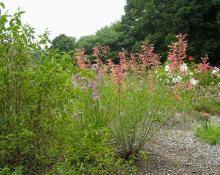
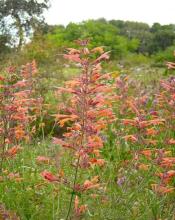
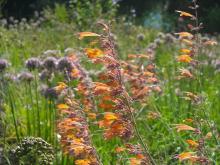
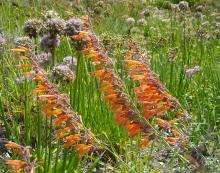
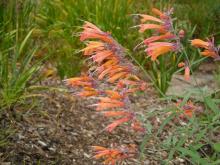
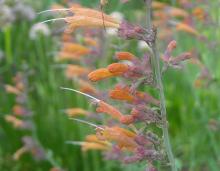
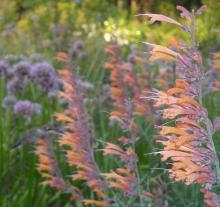
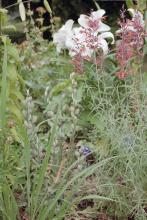
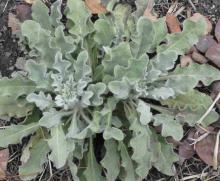
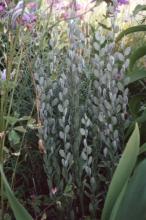
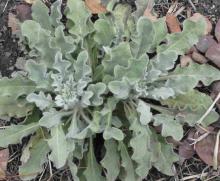
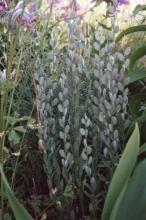
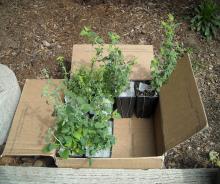
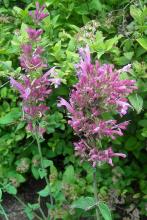
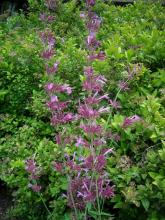
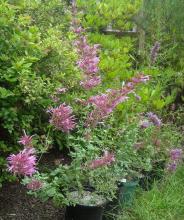
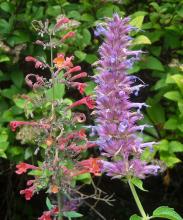
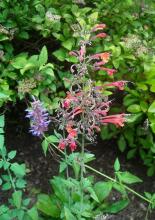
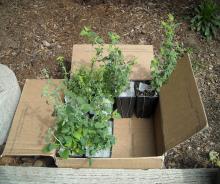
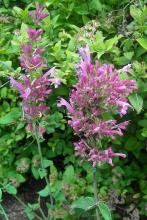
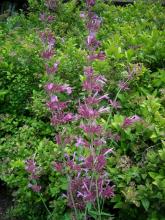
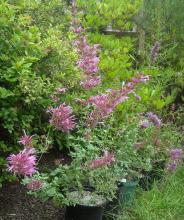
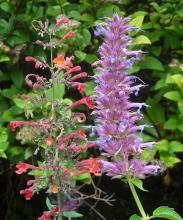
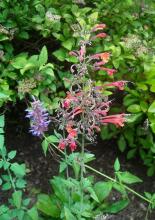
Neither Agastache rupestris and A. aurantiaca proved very long lived; after a few years these woody plants tend to die out, replaced by seedlings. However, all the seedlings that appeared were hybrids between the two species. Moving forward with this genus, I think it might be wise to take cuttings each year and over-winter them with protection, and set them out again in spring for better insurance that your more colorful forms continue on. All that I have now are the A. aurantiaca x rupestris hybrids, but I love these too.
On the left, a 2-year old seedling plant of the hybrid, on the right, a close-up view of the soft multi-hued blooms and bracts:
Two photos of the racemes of bloom on sunny days in July and August:
Two close-up photos of the racemes of late bloom, one in September, on overcast days:
While photographing the blooms one late afternoon with dwindling light, I heard a vibrant whir while taking a photo, and I didn't realize until later it was a hummingbird... he's a bit out of focus on the left, but he's there. I often sit in the garden and simply observe, and the hummers always come around to feed on the Agastache blooms.